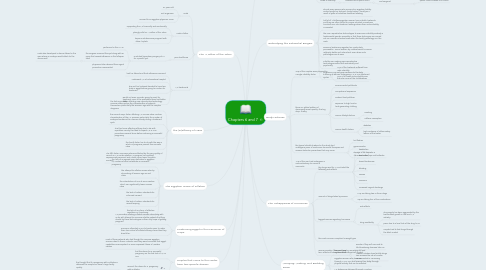
1. couples that come to the center have two specific desires
1.1. first the desire for a successful pregnancy on the first trial of IVF or ICSI
1.2. second, the desire for a pregnancy with mutliples
1.2.1. the thought that if a pregnancy with multiples is obtained the couple can have a large family quickly
1.2.2. having only one child is socially acceptable
2. the (in)efficacy of NRTs
2.1. the first major factor affecting new reproductive technology success rates involves the characteristics of patients themselves, particularly the woman's age and the couples diagnosis
2.2. the second major factor affecting IVF success rates involves characteristics of the IVF process, particularly the number of embryos transferred to a woman's body during a treatment cycle
2.3. The third issue affecting efficacy has to do with repetition namely the need to repeat IVF or ICSI procedures several times before achieving a successful pregnancy
2.4. the fourth factor has to do with the way in which ivf programs present their success rates
2.5. The fifth factor is success rates are affected by the very quality of care at an IVF center whether "a program has qualified experienced personnel and a track record open to public scrutiny"
3. The Egyptian Game of Inflation
3.1. the lack of an agreed upon definition in Egyptian IVF centers of what constitutes a successful pregnancy
3.2. the attempt to inflate success rates by eliminating all women age 40 and older
3.3. the introduction of ICSI at some centers which can significantly lower success rates
3.4. the lack of uniform standards for informed consent
3.5. the lack of uniform standards for record keeping
3.6. the lack of any form of effective regulation or monitoring
4. The "Mother of the Tube"
4.1. Huda
4.1.1. 27 years old
4.1.2. civil engenieer
4.1.3. married to an Egyptian physician Omar
4.2. Huda's father
4.2.1. supporting the IVF financially and emotionally
4.2.2. jokingly calls her "Mother of the Tube"
4.2.3. hopes Huda becomes pregnant with "tube" triplets
4.3. poor healthcare
4.3.1. Huda had laparotomy surgery at 16 for a painful cyst
4.3.1.1. performed in the U.A.E.
4.3.1.2. the surgeon removed the cyst along with an ovary that caused adhesions in the fallopian tube
4.3.1.2.1. Huda also developed a uterine fibroid in the area where an embryo would attach to the uterine wall
4.3.1.3. physicians later deemed the surgical procedure unwarranted
4.4. IVF treatments
4.4.1. had her fibroid and thick adhesions removed
4.4.2. underwent IVF at Nile Badrawi hosiptal
4.4.3. she and her husband decided to have two trials in Egypt before going to London for treatment
4.4.4. would not even consider going to Israel for treatment; even if the procedure there had better odds
5. Positioning Egypt in the Discourse of Hope
5.1. IVF providers invoking inflated success rates along with G-d's will, attempt to convince infertile patients that they should try these technologies as their only hope of getting pregnant
5.2. success is ultimately in G-d's hands, seem to make them less critical of inflated efficacy claims than they should be.
5.3. most of those patients who had thought to compare Egyptian success rates to those "outside" said they were convinced that Egypt' capabilities now equaled, or even surpassed, those of Western centers
6. Realities of Success and Failure
6.1. 66 women in study
6.1.1. 38 had never been pregnant
6.1.2. 11 are experiencing secondary fertility
6.1.2.1. 8 had no living children
6.1.2.2. 3 had living children
6.1.3. 17 had success with IVF or ICSI
6.1.3.1. 10 were currently pregnant
6.1.3.1.1. 5 were pregnant with twins
7. The Movie Star Patient
7.1. Nadine
7.1.1. Egyptian Celebrity
7.1.2. twice married
7.1.2.1. first marriage to a physician
7.1.2.2. second marriage to a wealthy contractor
7.1.3. pregnant 16 times
7.1.3.1. 15 abortions
7.1.3.2. 1 miscarriage at 24 weeks
7.1.3.2.1. could have been caused by a fibroid tumor
7.1.3.2.2. believes the miscarriage was caused by "nerves"
7.1.4. cause of infertility
7.1.4.1. husband has 0 sperm count
7.1.4.1.1. husband took fertility drugs Clomid and Pergonal
8. Body Histories
8.1. 75% of the couples were plagued by a single infertility factor
8.1.1. 71% of the husbands suffered from male infertility
8.1.2. 47% of all cases male infertility was the sole cause of the childlessness
8.2. there is a global pattern of decreasing semen quality "the big drop" theory
8.2.1. environmental pollutants
8.2.2. occupational exposures
8.2.3. ambient lead pollution
8.2.4. exposure to high heat or heat-generating clothing
8.2.5. various lifestyle factors
8.2.5.1. smoking
8.2.5.2. caffeine consuption
8.2.6. various health factors
8.2.6.1. diabetes
8.2.6.2. high incidence of inflammatory lesions of the testes
8.3. the typical infertile husband in this study had undergone years of continuous hormonal therapies and invasive testicular procedures that may cause
8.3.1. hot flashes
8.3.2. gynecomastia
8.3.3. storage of fat deposits in "feminine" sites (hips and buttocks"
8.4. 17% of the men had undergone a varicocelectomy to correct a varicocele
9. The Unhappiness of Hormones
9.1. the drugs used for IVF included the following side effects
9.1.1. headaches
9.1.2. backaches
9.1.3. breast tenderness
9.1.4. bloating
9.1.5. nausea
9.1.6. insomnia
9.1.7. increased vaginal discharge
9.2. amount of drugs taken by women
9.2.1. 61% are taking two or three drugs
9.2.2. 9% are taking four of five medications
9.3. biggest worries regarding hormones
9.3.1. side effects
9.3.2. drug availability
9.3.2.1. drug supply has been aggravated by the tremendous growth in the local IVF industry
9.3.2.2. panic due to a local lack of the drug hMG
9.3.2.3. couples had to find drugs through the black market
9.4. the most common complaint is weight gain
9.5. women wonder if there are long term effects of taking hormones
9.5.1. wonder if they will succumb to life-threatening diseases later on
9.5.2. Western studies show fertility drugs can increase the risk of ovarian cancer
